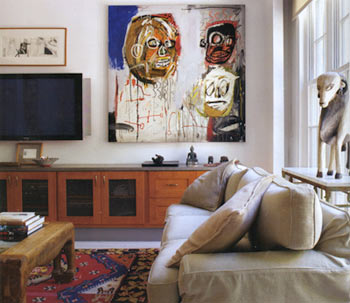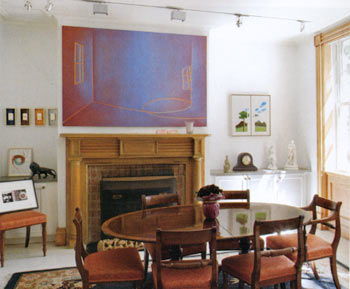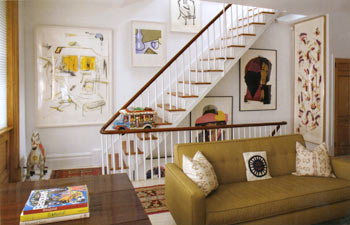Art Love Affair
Art Love Affair, Partners In Art Thrive On The Collection Process
By Eric Cohler for American Art Collector, Oct. 2008

Cerebral, dynamic, exciting, courageous, luminous—these adjectives are reserved for the ineffable and I have never before grouped them into the same sentence. I may not do so again, but the collection that James Cottrell, an anesthesiologist, and Joseph Lovett, a documentary film maker, have assembled commands superlatives. The partners have collected art since the late 1970s, amassing a collection that is, in a word, dazzling.
Jim and Joe’s journey through the ensuing years has brought them in close proximity to a rarified world of artists and their salons that most collectors seldom see. Meeting and becoming friends with many artists is as much a part of their raison d’être as is the process of collecting.
Their collection is unique, featuring a strong core of French contemporary art as well as work by contemporary American and European artists. Jim and Joe’s collection has traveled the country, exhibited at regional museums from the Orlando Museum of Art (OMA) to the Chelsea Art Museum in New York to the North Dakota Museum of Art. When the collection is on exhibition, it’s as much theirs as it is the publics. Jim and Joe are passionate about sharing their vision with other collectors, artists and students. Their world view is a broadly focused one in which they hope to inculcate others with the verve that ignites their own imaginations.
I spoke with Jim, Joe and their “co-conspirator” in collecting, art advisor Elizabeth Fiore, with little sense ahead of our interview of the depth of purpose that they all share. The trio’s enthusiasm bubbled over, and after our conversation I spent the afternoon looking at art and reading quotes by these artists. One quote that struck a chord and sums up all that I learned was written by the Spanish master of modern, Joan Miró: “Je Traville comme un jardiner,” literally translates “I work like a gardener,” cutting and pruning until the true form of the garden—or in Jim and Joe’s case—the art is revealed.
Eric Cohler: I am mesmerized by the color and intensity of your collection. It’s like delving into someone’s inner conscious. How did you begin?

James Cottrell: Joe and I began collecting individually before we met and I don’t think that either of us thought of ourselves as serious collectors. It wasn’t until we combined households that we realized we had the genesis of a collection.
Joseph Lovett: I don’t think that either of us had set out on our own to build a collection. It was definitely an evolutionary process.
Elizabeth Fiore: That’s true of most collectors. What set Joe and Jim apart is that they both have a love affair with the physicality of the process of collecting. It’s definitely a journey for them; meeting the artists, touring studios, speaking with gallery owners and collaborating with museums and curators.
EC: The fluidity of their collecting is what impresses me. It goes beyond intellectual curiosity.
EF: Theirs is an expressive quality, a thought-process revolving around shared interests and living artists.
EC: How have you helped Jim and Joe with the collection?
EF: In an advisory capacity; especially with the French and European works. I studied in Paris and lived there for many years, developing strong relationships with French dealers and artists. We met years ago at the French Counsel General in New York at an exhibit of several of Jim and Joe’s paintings.
JL: Jim and I both spent quite a bit of time in France. And in Jim’s professional life he is traveling the world constantly, so this gives him an unusual perspective.
JC: We started our collection with French contemporary art when that wasn’t the fashionable thing to do.
JL: Contemporary French art and artists speak to us, but our collection is broad and varied.
EC: Iconoclastic art seems to speak to you, period. There is no herd mentality about the direction that the collection has taken. Your focus is clear and sharply defined.
JL: Collecting goes beyond contemporary art of a certain school or genre. What we thrive on is meeting artists and learning from them, seeing their studios, talking to them about how they make art; the process.

EC: How large is the collection?
JC: Over 400 pieces.
EC: And growing?
JL: And growing. We collect all the time, and when we aren’t collecting we are learning—visiting studios, galleries, museums, art fairs and reading as much as possible pertaining to contemporary art. This can be a mixed blessing. We have limited wall space, and many of our pieces are too large to fit up the stairs. Most of our collection is relegated to storage.
JC: I hop in and out of galleries and museums wherever I am and whenever possible. Art helps to sustain me when I’m away from home.
JL: Jim and I were returning from a trip out West when our flight was delayed and we happened to meet a young artist who was studying painting at Brooklyn’s Pratt Institute. She greatly impressed us and we exchanged numbers. A few months later she contacted us out of the blue and invited us to one of her first shows.
JC: We went to her exhibition and fell in love. Naturally we bought a painting.
JL: Guests come over for dinner and frequently ask us about her work. This is incredibly gratifying.
EF: Collecting is often about the art and the artist more than the name. I explain this time and again. Art is about an exchange of ideas and information; it’s not merely about an investment in monetary terms.
EC: Living with art day in and day out is heady stuff, but what I want to know is if you “see” the art or if it fades into the background over time?
JC: We have a visceral connection with our art, but at times it can become static and that’s what’s so wonderful about the touring exhibitions.
JL: Our collection came alive with the exhibition at OMA. Jim had worked with the curators to make the show happen. It was in walking through gallery after gallery, truly viewing the art, that I was able to see the collection coalesce.
JC: I was inspired by what we had created. Hanging the show was done instinctively, enabling me to develop new relationships between different works.
JL: The show was about our art speaking harmoniously. There was a large expenditure of intellectual rigor on Jim’s part.
JC: Actually, it wasn’t work for me; the process was amazingly cathartic. In building a collection it’s easy to lose the thread of connectivity; when our collection was hanging, including work that we had never seen in one space before, it all clicked.
EC: Are there particular artists that you are focusing on currently?
JC: The core of our collection consists of work by Roland Flexner, Philippe Mayaux, Edouard Prulhiere, Barton Benes, and Dominique Figarella, These are seminal figures in world art today.

EC: What are some of the earliest pieces that you collected?
JC: We purchased a Basquiat at a fund-raiser for the Gay Men’s Health Crisis.
JL: When a Basquiat was affordable. He was virtually unknown then.
JC: We are always concerned about an artist making a living.
EC: Are there artists you’d like to add to the collection?
JL: If money were no object?
EC: Exactly.
JL: A Milton Avery and a large Hockney pool painting.
JC: Hans Hoffman and an early Philip Pearlstein.
EC: All artists with a similar calmness and dynamic sense of composition: favorite museums?
JC: The Tate in London and the Pompidou in Paris.
JL: The Louvre when it was dark and mysterious and there was a sense of discovery.
EC: Cities for art?
JC: Berlin—stunning galleries and art scene.
JL: And Buenos Aires.
EC: Favorite studio visit?
JL: Barton Benes.
EC: An amazing artist. He literally creates beauty from recycled detritus.
JL: The North Dakota Museum of Art is constructing a gallery to exhibit a retrospective of Barton’s work over the past 40 years.
JC: For me, I would have liked to visit Dubuffet in his studio.
EC: Advice to other collectors?
JC: See as much as you can, never stop looking and learning.
JL: Buy with your heart.
JC: Dialogue with an artist. Take it out of a one-dimensional experience. It’s a learning curve, a constant give and take.
EF: Make art a physical experience; get out and explore. Do the research and never be afraid to ask questions. What’s extraordinary about working with Jim and Joe is their sense of commitment not only to the tangible, but to the artists themselves.
EC: To quote Jim from the introduction to the OMA catalogue: “When I see a painting that I really love, the images stays in my mind, it persists. Whether I buy it or not, it haunts me.”
[hr]
Eric Cohler, president of Eric Cohler Inc., holds a master’s degree in Historic Preservation from the Columbia School of Architecture. He won a Designer of the Year Award in 1998 and in 2000 the D&D Building in New York recognized him as one of the 26 leading designers in the U.S. Eric has appeared on CBS Morning and Evening News and CNN Style and he is a featured designer on the Home & Garden TV Network.